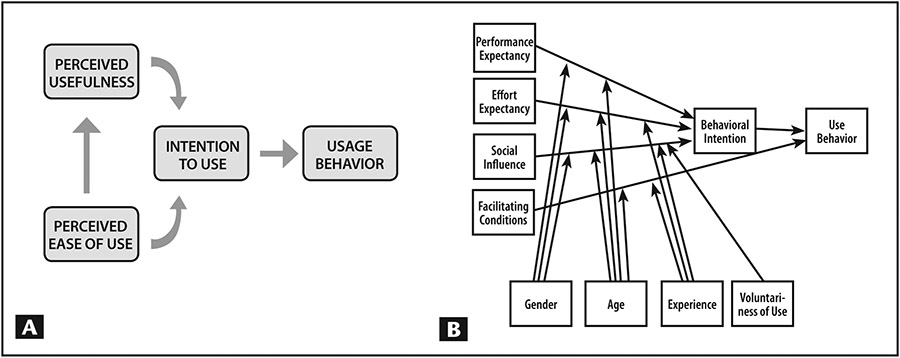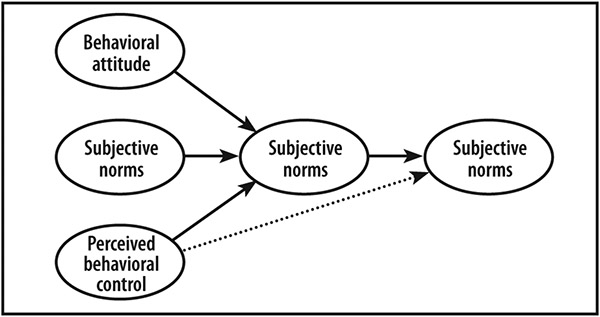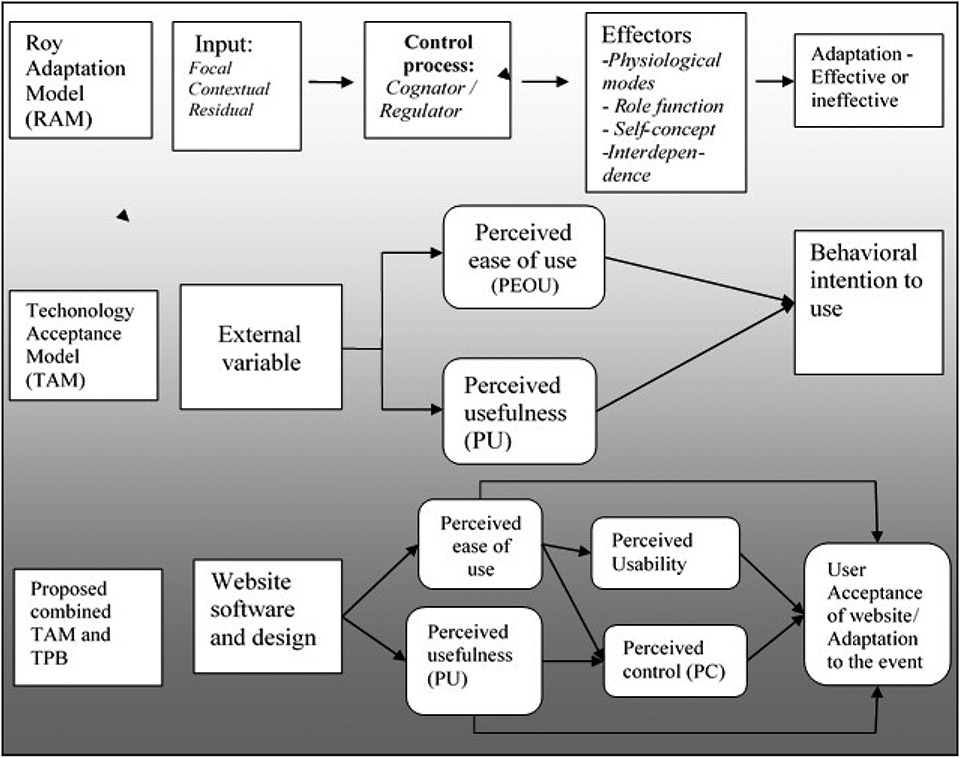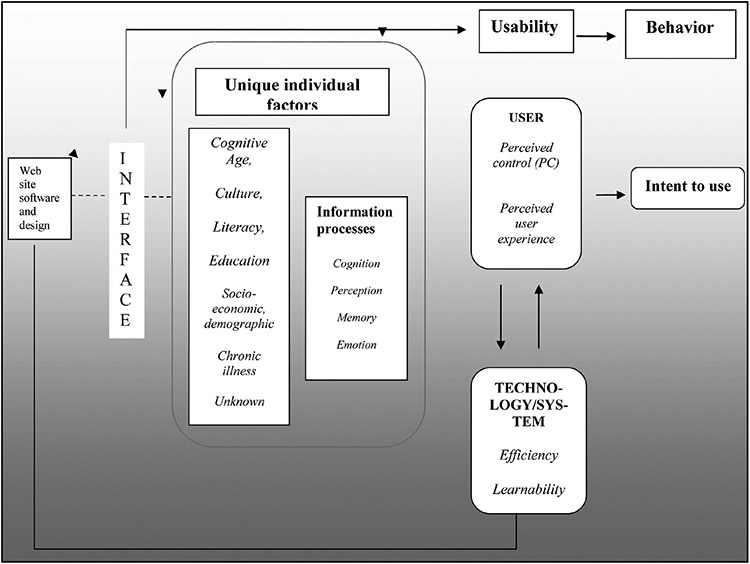Abstract
The purpose of the current study was to present a framework to determine potential usability of health websites by older adults. Review of the literature showed paucity of nursing theory related to the use of technology and usability, particularly in older adults. The Roy Adaptation Model, a widely used nursing theory, was chosen to provide framework for the new model. Technology constructs from the Technology Acceptance Model and United Theory of Acceptance and Use of Technology and behavioral control construct from the Theory of Planned Behavior were integrated into the construction of the derived model. The Use of Technology for Adaptation by Older Adults and/or Those With Limited Literacy (U.S.A.B.I.L.I.T.Y.) Model© was constructed from the integration of diverse theoretical/conceptual perspectives. The four determinants of usability in the conceptual model include (a) efficiency, (b) learnability, (c) perceived user experience, and (d) perceived control. Because of the lack of well-validated survey questionnaires to measure these determinants, a U.S.A.B.I.L.I.T.Y. Survey© was developed. A panel of experts evaluated face and content validity of the new instrument. Internal consistency of the new instrument was 0.96. Usability is key to accepting technology. The derived U.S.A.B.I.L.I.T.Y. framework could serve as a guide for nurses in formative evaluation of technology.
An aging population and surge in the use of information technology are two sociocultural trends occurring simultaneously (United States Department of Health and Human Services [USDHHS], 2012). In 2011, an estimated 41.1 million Americans were older than 65 (USDHHS, 2012). This number is projected to double by 2050 (Centers for Disease Control and Prevention [CDC], 2013). For the first time, older adults are the fastest growing Internet users in the United States (Smith, 2014). In 2013, 86% of adults ages 50 to 64 and 56% of adults 65 and older used the Internet or e-mail (Smith, 2014). Of these, 70% of those 65 and older who use the Internet go online daily (Zickuhr & Madden, 2012). On a personal level, older adults use the Internet to communicate with family members or friends through e-mail and social networking, including Facebook® (Rainie, 2010; Wagner, Hassanein, & Head, 2010; Zickuhr & Madden, 2012). Statistics have shown that seven in 10 older adults own a digital device, a 57% rise from 2010 (Zickuhr & Madden, 2012). Studies have also shown that an increasing number of older adults are searching the Internet for health information (Cohen & Stussman, 2010; Fox & Jones, 2009).
Information technology (IT) offers an alternative approach to delivering health information (Beranova & Sykes, 2006; Ryan, Pumilia, Henak, & Chang, 2009; Wallington, 2008). IT can facilitate individuals’ involvement with their care, but it can also become a barrier if it cannot meet their goals and needs. Despite the surge of e-health information, numerous websites are not always user-friendly and reliable for older adults, leading to concerns about quality of information being disseminated to older users. An important issue to address is how to make software designs user-friendly for older adults. Human factor and cognitive ergonomic specialists have suggested that age-related cognitive and functional changes must be considered to ensure that the demands of technology fit the user’s capabilities (Charness & Boot, 2009). Users’ acceptance of technology is an important field of study; thus, usability is key for accepting the technology. Several models exist that predict intent to use technology. However, there is paucity in nursing literature of a model that could explain or predict the intent to use technology by older adults.
USABILITY
The term usability came from the field of cognitive ergonomics, a branch of the human–computer interaction (HCI) (Barnum, 2011; Kools, 2007). HCI studies the relationship between the computer system and user and intersects other disciplines, including computer science, information system, design, and behavioral science (Jacko, 2012). HCI aims to understand human information processing and cognition, including memory, vision, and motor skills, to complete a task toward specific goals (Hassenzahl & Tractinsky, 2006). Usability is concerned with the interface between human cognition and software design (Barnum, 2011; Kools, 2007) and measures the effectiveness and efficiency of a product to the user as well as user satisfaction with the use of the product (Barnum, 2011). Usability follows the HCI principles concentrating on (a) the user and his or her tasks, and (b) the iterative development and empirical measurement of the system (Levi & Conrad, 2008).
Definitions of Usability
Usability is defined in the online Merriam-Webster Dictionary (n.d.) as “the effectiveness, efficiency and satisfaction with which the users can achieve tasks in a particular environment of a product.” High usability means that the system is easy to learn and remember, visually pleasing and fun to use, efficient, and recovers quickly from error (Merriam-Webster Dictionary n.d.). Nielsen (1996) was one of the first to define usability as the measure of quality that the user experiences. He later defined it as a “quality attribute that assesses how easy user interfaces are to use” (Nielsen, 2012, p. 1). Usability is also referred to as the method of improving ease of use during the design process (Nielsen, 2012). In addition to the five quality attributes of usability, another important attribute is utility, which refers to the design’s functionality (Nielsen, 2012). Hence, usability and utility are equally important factors for determining if something is useful (Nielsen, 2012). The standard definition of usability from the International Organization for Standardization 9241-11 is the “extent to which a product can be used by specified users to achieve specified goals with effectiveness, efficiency and satisfaction in a specified context of use” and “how well and how easily a user, without formal training, can interact with an information system of a website (Benbunan-Fich, 2001, p. 151). Usability is the “perception of how consistent, efficient, productive, organized, easy to use, intuitive, and straightforward it is to accomplish tasks within the system” (McGee, Rich, & Dumas, 2004, p. 909). Usability refers to the degree (i.e., extent) by which the user and system, through their interface, “communicate” clearly and effectively without misunderstanding (Benbunan-Fich, 2001, p. 152).
Usability Testing/Evaluation
Usability testing is the “activity that focuses on observing users working with a product, and performing tasks that are real and meaningful to them” (Barnum, 2011, p. 13). Two types of usability evaluation include summative and formative evaluation. Formative evaluation is conducted during the iterative development of the design, whereas summative evaluation is performed after the product has been released (Tullis & Albert, 2008).
Purpose
The purpose of the current article is to present a conceptual model designed from integration of several theories and concepts that could explain or predict the potential intent to use a health website by older adults.
Method
A situation-specific approach to theory development by Meleis (2012) was used in developing the conceptual model. Table 1 presents the process adapted in the development of the conceptual model.
TABLE 1.
The Adapted Process of Developing Situation-Specific Theories
| 1. Study middle-range theory. |
| 2. Specify characteristics of the population and their experiences. |
| 3. Describe a limited scope of experiences and responses. |
| 4. Identify assumptions based on what is known about the population’s experiences. |
| 5. Review research; practice literature; and redefine concepts, propositions, assumptions, and outcomes. |
| 6. Develop a framework with concepts, propositions, assumptions, and outcomes. |
| 7. Provide clinical and research exemplars. |
| 8. Critique emerging theories. |
| 9. Communicate the emerging theory through different methods, such as presentations and publications. |
Adapted from Meleis, A.I. (2012). Middle-range and situation-specific theories. In Theoretical nursing: Development and progress (5th ed., p. 424). Philadelphia, PA: Wolters Kluwer Health/Lippincott Williams & Wilkins.
THEORY INTEGRATION
Roy Adaptation Model
The Roy Adaptation Model (RAM) is a widely used theoretical base in nursing research because it presents how an individual continuously adapts to external stimuli (Roy, 1984). Roy (1984) asserted that an individual has the ability to adapt with the changing environment using his or her regulator and cognator. Adaptive processes that influence an individual’s way of adapting include perception, cognition, learning, information processing, emotions, and memory. These processes produce responses that are performed through the effector, which will eventually lead to effective or ineffective adaptation (Roy, 1984). To date, the RAM has not been tested with the use of technology.
Technology Models
The Technology Acceptance Model (TAM) and the Unified Theory of Acceptance and Use of Technology (UTAUT) are two widely known technology models predicting the use and acceptance of technology (Davis, 1989). Davis (1989) first proposed the TAM in his doctoral thesis at the MIT Sloan School of Management in 1985. The theory identified two specific determinants, perceived ease of use (PEOU) and perceived usefulness (PU), which could predict the user’s attitude toward his or her intention to use of technology (Davis, 1989). Limitations of the TAM were that it could only predict behavior after the user had the opportunity to use the system and it did not offer feedback from the user to lend in the redesign of the system. Similar to the TAM, the UTAUT by Venkatesh, Morris, Gordon, and Davis (2003) aimed to explain the user’s intention to use and his or her actual use behavior based on four constructs: performance expectancy (equivalent to PU), effort expectancy (equivalent to PEOU), social influence (equivalent to subjective norm in the Theory of Planned Behavior [TPB]), and facilitating condition. At the same time, gender, age, experience, and voluntariness to use are moderating factors that may impact the four constructs on use intention and behavior (Venkatesh et al., 2003). Figure 1 depicts both technology models.
Figure 1.
(A) Technology Acceptance Model (Davis, 1989) and (B) the United Theory of Acceptance and Use of Technology (Venkatesh, Morris, Gordon, & Davis, 2003).
Adapted from Davis, F.D. (1989). Perceived usefulness, perceived ease of use, and user acceptance of information technology. MIS Quarterly, 13, 319-340; and Venkatesh, V., Morris, M.G., Gordon, B.D., & Davis, F.D. (2003). User acceptance of information technology: Toward a unified view. MIS Quarterly, 27, 425-478.
Theory of Planned Behavior
An extension of the Theory of Reasoned Action is the TPB (Figure 2), which added perceived control (PC) in the theoretical equation (Ajzen, 1991). The TPB posits that human actions are guided by behavioral, normative, and control beliefs. The Use of Technology to Engage in Adaptation by Older Adults and/or Those With Low or Limited Literacy (U.S.A.B.I.L.I.T.Y.) model© believes that perceived behavioral control is the most important aspect that could predict individual attitudes toward a specific behavior.
Figure 2.
Theory of Planned Behavior. Adapted from Ajzen, I. (1991). The theory of planned behavior. Organizational Behavior and Human Decision Processes, 50, 179-211. doi:10.1016/0749-5978(91)90020-T
Conceptualization
Figure 3 displays the integration of the three models (i.e., RAM, TAM, and TPB) in the conceptualization of the current model, U.S.A.B.I.L.I.T.Y.
Figure 3.
Initial schematic of the conceptualized Use of Technology for Adaptation by Older Adults and/or Those With Limited Literacy Model©.
Note. TAM = Technology Acceptance Model; TPB = Theory of Planned Behavior.
PRESENTATION OF THE U.S.A.B.I.L.I.T.Y. MODEL
To conceptualize usability for older adults, diverse theoretical perspectives were integrated in developing the U.S.A.B.I.L.I.T.Y. conceptual model (Figure 4). The basic tenet of the U.S.A.B.I.L.I.T.Y. model is that older adults and/or those with low or limited literacy will use a website or online resource for health information based on their perceived usability of that website. The conceptual U.S.A.B.I.L.I.T.Y. model has the following assumptions:
Figure 4.
Pictorial representation of the derived Use of Technology for Adaptation by Older Adults and/or Those With Limited Literacy Model©.
When an individual turns on a device, he or she interfaces with the system and design, and operates in an environment of learning.
The user affects the state of the machine by manipulating the controls.
The user processes information based on his or her own unique, individual factors.
Interface between the user and system is influenced by four determinants: (a) efficiency, (b) learnability, (c) perceived user experience, and (d) PC.
The user’s perceived usability of the website leads to the intention to use or not use the technology.
Determinants of the U.S.A.B.I.L.I.T.Y. Model
The determinants of the conceptual U.S.A.B.I.L.I.T.Y. model are categorized into user and computer system components. The user component includes perceived user experience and PC, whereas the computer system component includes learnability and efficiency. Table 2 presents the constructs, definitions, and measures of the U.S.A.B.I.L.I.T.Y. model.
TABLE 2.
U.S.A.B.I.L.I.T.Y. Model© Elements, Definitions, and Metrics
| Element | Definition | Metrics |
|---|---|---|
| Learnability | Easiness of learning the system and retrieving information from the system. | Learnability |
| Efficiency | Amount of effort required to use the system and usefulness in meeting the user’s needs and goals. | Perceived ease of use and perceived usefulness |
| Perceived user experience | Level of pleasantness in using the system and the quality of the system’s design. | Perceived user experience |
| Perceived control | Amount of control users have to choose and decide how to proceed. | Attitudinal and cognitive control |
Efficiency.
The efficiency of technology or the system is based on the determinants of TAM (Davis, 1989). PEOU is defined as the “degree to which a person believes that using a particular system would be free of effort, whereas PU is the degree to which a person believes that using a particular system would enhance his or her job performance” (Davis, 1989, p. 320).
Learnability.
Learnability is an important component of usability. Experts disagree as to how learnability should be defined despite the consensus that it is an important aspect of usability. The taxonomy of learnability is based on user experience and “the ability to perform well and to the ability to eventually achieve optimal performance, for the user with no experience with the interface” (Grossman, Fitzmaurice, & Attar, 2009, p. 651).
Perceived User Experience.
User experience is the holistic experience of interacting with a given product (Nurkka, Kujala, & Kemppainen, 2009). The actual experience assumes that all unique elements of the product and internal states of the user are interrelated and interact and modify each other from beginning to end (Hassenzahl & Tractinsky, 2006). In addition, user experience is the consequence of a user’s internal state, characteristics of the designed system, and context within which interaction occurs (Hassenzahl & Tractinsky, 2006).
Perceived Control.
PC can predict an individual’s behavior, emotion, motivation, performance, success, and failure (Skinner, 1996). There are three facets of PC: (a) cognitive, (b) decisional, and (c) behavioral control (Morris & Marshall, 2004). Cognitive control relates to how an individual interprets an event by gathering information and appraisal (Averill, 1973). Decisional control refers to the opportunity to choose from different courses of action. Behavioral control occurs when an individual uses direct means to exert influence over an event (Averill, 1973). Older users who are computer and Internet literate are empowered to use all facets of PC for successful interface.
INSTRUMENT DEVELOPMENT
The lack of well-validated instruments that measure the four determinants of usability in the conceptual model precipitated the development of the U.S.A.B.I.L.I.T.Y. Survey©. The 25-item survey questionnaire offered answers on a 5-point Likert scale, ranging from 1 (strongly disagree) to 5 (strongly agree), that has user and system components. The system component of the survey included efficiency and learnability, whereas the user component included PUE and PC. Survey scores ranged from 29 to 121 (scores ≥98 indicated that the system is considered usable). A panel of experts evaluated the new instrument’s face and content validity. Polit and Beck’s (2006) method of content validity estimation for relevance was used to calculate content validity. The item-content validity and overall scale averaging calculation was 0.97. Internal consistency was used to assess reliability. The total-item correlation coefficient of the instrument was 0.96.
IMPLICATIONS
Technology has the potential to improve health care quality and cost. Technology use is becoming a crucial part of patient care, and older adults are the inadvertent recipients of this care due to increased incidence of chronic illness. Older adults embracing the use of technology could be a complex issue, particularly if their interface is unsuccessful. Nurses should be cognizant of the issues related to older adults’ use of technology. Nurses should also be involved in the iteration process of new systems. The U.S.A.B.I.L.I.T.Y. model could serve as a guide in the formative evaluation of new technology.
CONCLUSION
Usability is key to accepting technology. The user’s perception of a given technology is affected by his or her awareness of the fact that technology will or will not allow him or her to complete a task (Dillon & Morris, 1999). Older adults are becoming the fastest growing population of Internet users; however, cognitive and functional limitations may cause challenges in their use of technology. The intention to use a website depends on its usability. The use of technology or online resources offers invaluable benefits to older adults in maintaining their independence and increasing engagement, which could improve health outcomes.
Footnotes
The authors have disclosed no potential conflicts of interest, financial or otherwise.
Contributor Information
Meriam Caboral-Stevens, State University of New York Downstate Medical Center, Brooklyn.
Martha V. Whetsell, Graduate Center, Hunter College, City University of New York, New York, New York; Lehman College, Bronx, New York.
Lorraine S. Evangelista, University of California, Irvine, Irvine, California.
Brigitte Cypress, Lehman College, Bronx, New York.
Donna Nickitas, Graduate Center, Hunter College, City University of New York, New York, New York.
REFERENCES
- Ajzen I (1991). The theory of planned behavior. Organizational Behavior and Human Decision Processes, 50, 179–211. doi: 10.1016/0749-5978(91)90020-T [DOI] [Google Scholar]
- Averill JR (1973). Personal control over aversive stimuli and its relationship to stress. Psychological Bulletin, 4, 286–303. [Google Scholar]
- Barnum CM (2011). Usability testing essentials: Ready. Set…test Burlington, MA: Elsevier. [Google Scholar]
- Benbunan-Fich R (2001). Using protocol analysis to evaluate the usability of a commercial website. Information & Management, 39, 151–163. doi: 10.1016/S0378-7206(01)00085-4 [DOI] [Google Scholar]
- Beranova E, & Sykes C (2006). A systematic review of computer-based software for educating patients with coronary heart disease. Patient Education and Counseling, 66, 21–28. doi: 10.1016/j.pec.20006.09.006 [DOI] [PubMed] [Google Scholar]
- Centers for Disease Control and Prevention. (2013). The state of aging and health in America 2013. Retrieved from http://www.cdc.gov/features/agingandhealth/state_of_aging_and_health_in_america_2013.pdf
- Charness N, & Boot WR (2009). Aging and information technology use. Current Directions in Psychological Science, 18, 253–258. doi: 10.1111/j.1467-8721.2009.01647.x [DOI] [Google Scholar]
- Cohen RA, & Stussman B (2010). Health information technology use among men and women aged 18–64: Early release of estimates from the National Health Interview Survey, January-June 2009. Retrieved from http://www.cdc.gov/nchs/data/hestat/healthinfo2009/healthinfo2009.pdf [Google Scholar]
- Davis FD (1989). Perceived usefulness, perceived ease of use, and user acceptance of information technology. MIS Quarterly, 13, 319–340. [Google Scholar]
- Dillon A, & Morris M (1999). Power, perception and performance: From usability engineering to technology acceptance with the P3 model of user response. Proceedings of the 43rd Annual Conference of the Human Factors and Ergonomics Society (pp. 1017–1021). Santa Monica, CA: Human Factors and Ergonomics Society. [Google Scholar]
- Fox S, & Jones S (2009). The social life of health information. Retrieved from http://www.pewinternet.org/Reports/2009/8-The-Social-Life-of-Health-Information.aspx [Google Scholar]
- Grossman T, Fitzmaurice G, & Attar R (2009). A survey of software learnability: Metrics, methodologies and guidelines. Proceedings of the 27th International Conference on Human Factors in Computing Systems (pp. 649–658). Boston, MA: CHI; 2009. [Google Scholar]
- Hassenzahl M, & Tractinsky N (2006). User experience: A research agenda. Behavior & Information Technology, 25, 91–97. doi: 10.1080/01449290500330331 [DOI] [Google Scholar]
- Jacko JA (2012). The human-computer interaction handbook: Fundamentals, evolving technologies and emerging applications (3rd ed.). Boca Raton, FL: CRC Press. [Google Scholar]
- Kools M (2007). A focus on the usability of health education materials. Patient Education and Counseling, 65, 275–276. doi: 10.1016/j.pec.2006.12.014 [DOI] [PubMed] [Google Scholar]
- Levi MD, & Conrad FG (2008). Usability testing of the worldwide web sites. Retrieved from http://data.bls.gov/cgi-bin/print.pl/ore/htm_papers/st960150.htm [Google Scholar]
- McGee M, Rich A, & Dumas J (2004). Understanding the usability construct: User-perceived usability. Proceedings of the Human Factors and Ergonomics Society Annual Meeting, 48, 907–911. doi: 10.1177/154193120404800535 [DOI] [Google Scholar]
- Meleis AI (2012). Middle-range and situation-specific theories. In Theoretical nursing development and progress (5th ed., pp. 407–426). Philadelphia, PA: Wolters Kluwer Health/Lippincott Williams & Wilkins. [Google Scholar]
- Merriam-Webster Dictionary. (n.d). Usability. Retrieved from http://www.webster-dictionary.org/definition/usability
- Morris SA, & Marshall TE (2004). Perceived control in information systems. Journal of Organizational and End User Computing, 16, 38–56. doi: 10.4018/joeuc.2004040103 [DOI] [Google Scholar]
- Nielsen J (1996). Usability metrics: Tracking interface improvements. IEEE Software, 13, 12–14. [Google Scholar]
- Nielsen J (2012). Usability 101: Introduction to usability. Retrieved from http://www.nngroup.com/articles/usability-101-introduction-to-usability [Google Scholar]
- Nurkka P, Kujala S, & Kemppainen K (2009). Capturing users’ perceptions of valuable experience and meaning. Journal of Engineering Design, 20, 449–465. doi: 10.1080/09544820903158835 [DOI] [Google Scholar]
- Polit DF, & Beck CT (2006). The content validity index: Are you sure you know what’s being reported? Critique and recommendations. Nursing Research and Health, 29, 489–497. doi: 10.1002/nur.20147 [DOI] [PubMed] [Google Scholar]
- Rainie L (2010). The rise of the e-patient: Understanding social networks and online health information seeking. Retrieved from http://www.pewinternet.org/2011/05/05/the-rise-of-the-e-patient-understanding-social-networks-and-online-health-information-seeking/ [Google Scholar]
- Roy C (1984). Introduction to nursing: An adaptation model (2nd ed.). Upper Saddle River, NJ: Prentice Hall. [Google Scholar]
- Ryan R, Pumilia NJ, Henak B, & Chang T (2009). Development and performance usability testing of a theory-based, computerized, tailored intervention. Computers, Informatics, Nursing, 27, 288–298. doi: 10.1097/NCN.0b013e3181b21779 [DOI] [PubMed] [Google Scholar]
- Skinner EA (1996). A guide to constructs of control. Journal of Personality and Social Psychology, 71, 549–570. [DOI] [PubMed] [Google Scholar]
- Smith A (2014). Older adults and technology use. Retrieved from http://www.pewinternet.org/2014/04/03/older-adults-and-technology-use [Google Scholar]
- Tullis T, & Albert B (2008). Measuring the user experience: Collecting, analyzing and presenting usability metrics. Burlington, MA: Morgan Kauffmann. [Google Scholar]
- U.S. Department of Health and Human Services. (2012). A profile of older Americans: 2012. Retrieved from http://www.aoa.gov/Aging_Statistics/Profile/2012/2.aspx
- Venkatesh V, Morris MG, Gordon BD, & Davis FD (2003). User acceptance of information technology: Toward a unified view. MIS Quarterly, 27, 425–478. [Google Scholar]
- Wagner N, Hassanein K, & Head M (2010). Computer use by older adults: A multidisciplinary review. Computers in Human Behavior, 26, 870–882. doi: 10.1016/j.chb2010.03.029 [DOI] [Google Scholar]
- Wallington SF (2008). The internet as an emerging patient education tool among African-American men with prostate cancer: An exploratory study. American Journal of Men’s Health, 2, 106–121. doi: 10.1177/155798806296156 [DOI] [PubMed] [Google Scholar]
- Zickuhr K, & Madden M (2012). Older adults and internet use. Retrieved from http://pewinternet.org/Reports/2012/Older-adults-and-internet-use.aspx [Google Scholar]






